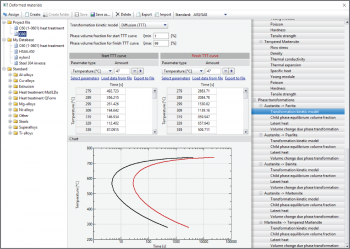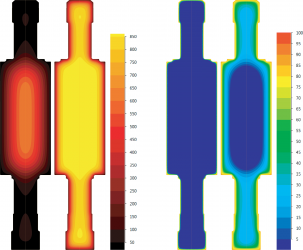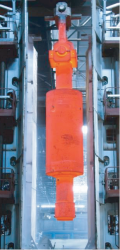QForm Heat Treatment (Phase transformation)
 QForm Phase transformation is a special module for simulation of different heat treatment processes.
QForm Phase transformation is a special module for simulation of different heat treatment processes.
The module is designed for simulation of heat treatment processes of alloys in a solid state either with or without polymorphic transformations (including steel, aluminum, nickel and titanium alloys).
It is possible to predict the phase composition and the operational properties of the workpiece after heat treatment (hardness, tensile strength) as well as residual stresses and strains during and after heat treatment.
The module places no restrictions on the nature of temperature changes at each step of the heat treatment process or the sequence and duration of these steps. It is possible to simulate the following processes: solution heat treatment, quenching (including interrupted quenching, stepped quenching, quenching with sprayers, isothermal quenching, quenching with subcooling, quenching with self-tempering), tempering and aging (including multistage processes).
 A special type of boundary conditions for spray quenching simulation. Temperature (ºC) distribution is shown
A special type of boundary conditions for spray quenching simulation. Temperature (ºC) distribution is shown Thermo-elastic-plastic problem simulation. Distribution of vertical displacement (mm) shows distortion of the quenched steel sheet
Thermo-elastic-plastic problem simulation. Distribution of vertical displacement (mm) shows distortion of the quenched steel sheet
QForm Heat Treatment can be used for simulation of phase transformations during the deformation process and cooling in the dies under the pressure as well as for additional operations in the technological chain such as heating, deformation and further heat treatment.
It is possible to simulate both direct and reverse phase transformations between any number of phases (including secondary metastable and stable phases) using common models of phase transformation kinetics: Johnson-Mehl-Avrami-Kolmogorov (JMAK), Koistinen-Marburger, Lee-Van Tyne, Leblonde-Devaux.
Heat release and volume change at phase transformations are calculated.
 Material database. Phases properties and phases transformation kinetics can be flexibly specified by the user or imported from any source.The user can specify initial data for a calculation (properties of the phases, kinetics of phase transformations, latent heat, coefficients of volume change at phase transformations, the equilibrium volume fraction of phases) and save it to QForm’s materials database.
Material database. Phases properties and phases transformation kinetics can be flexibly specified by the user or imported from any source.The user can specify initial data for a calculation (properties of the phases, kinetics of phase transformations, latent heat, coefficients of volume change at phase transformations, the equilibrium volume fraction of phases) and save it to QForm’s materials database.
Initial data about kinetics of phase transformations for low-carbon steels and phase properties for preliminary simulations can be calculated according to empirical dependences published in different scientific works by using the heat treatment coefficients calculator embedded in QForm.
All necessary initial data for heat treatment simulation of low-alloyed steels and carbon steels can be imported from JMatPro software.
 Ultimate strength (MPa) distribution in the connecting rod
Ultimate strength (MPa) distribution in the connecting rod  Hardness (HV) distribution after quenching. Bainite and martensite phases are shown
Hardness (HV) distribution after quenching. Bainite and martensite phases are shown
The heat treatment module allows the user to analyze the possibilities of optimization of technological processes of heat treatment, including:
• Optimization of the heating scheme of workpieces for reducing the duration, thermal stresses and nonuniform distribution of temperatures;
• Selection of optimum quenchant for obtaining the necessary operational properties, as well as minimizing residual stresses and warping of heat-treated workpieces;
• Evaluation of the possibility of using resource-saving variants of technological processes (for example, the introduction of quenching with self- tempering instead of individual quenching and tempering operations);
• Selection of temperatures
 Temperature (left, ºC) and martensite content (right, %) during quenching process
Temperature (left, ºC) and martensite content (right, %) during quenching process Quenching of the rotor in the sprayer device
Quenching of the rotor in the sprayer device
Also, implementation of MatILDa developed by GMS mbH, for prediction of phase transformations for 20 group of steels is included in QForm Heat Treatment.

 QForm Heat Treatment
QForm Heat Treatment


